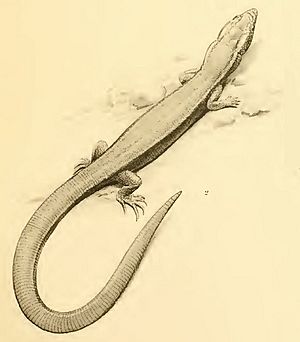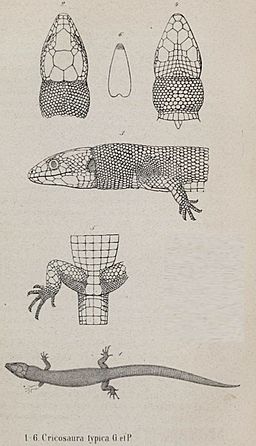Cuban night lizard facts for kids
Quick facts for kids Cuban night lizard |
|
|---|---|
 |
|
| Scientific classification | |
| Genus: |
Cricosaura
|
| Species: |
typica
|
The Cuban night lizard (Cricosaura typica) is a special kind of night lizard. It belongs to a group called Xantusiidae. This lizard lives only in southern Cuba. It is the only member of its genus called Cricosaura.
Contents
What's in a Name?
The name Cricosaura comes from ancient Greek words. "Krikos" means "ring" and "saura" means "lizard". This might be because of the ring-like scales on its tail.
The second part of its name, "typica", also comes from Greek. It means "typical".
What It Looks Like
The Cuban night lizard is quite small. It is the tiniest of all night lizards. Its body, not counting its tail, is less than 4 centimeters long. That's about the size of your thumb!
It has some unique scales on its head. It has two scales called frontonasal scales. It also has one frontal scale. Unlike some other lizards, it doesn't have a parietal scale. Its fourth finger has four small bones, called phalanges.
Where It Lives
Cricosaura typica lives only in a small part of southern Cuba. You can find it in the Granma and Santiago de Cuba Provinces. It lives in areas up to 200 meters above sea level.
Some places where it has been found include Hoyo de la Campana and Cabo Cruz in Granma Province. In Santiago de Cuba Province, it's known from La Mula and Uvero.
Its Home and Habits
The Cuban night lizard likes dry places. Scientists call this "xerophilic". It often hides under rocks, stones, logs, or other things on the ground. It looks for spots that are a bit damp, even in dry forests.
This lizard is mostly active at dawn and dusk. This is called "crepuscular". It can also be active during the day, which is "diurnal". But it is very good at staying hidden. Even though it's secretive, it's quite common in its habitat. People can often find it during the day.
When it moves on loose soil, it wiggles its body like a snake. It also moves its head.
What It Eats
The Cuban night lizard eats small creatures. Its main food is insects, especially ants. It also eats other small arthropods like Spiders and millipedes. Sometimes, it will eat molluscs and snails.
Eggs and Babies
This lizard is special because it's the only one in its family that lays eggs. Most other night lizards give birth to live young.
The female lizard lays white eggs. They are about 9.4 to 10.7 millimeters long. This usually happens between April and June in Cuba. The eggs take up to 60 days to hatch. When the babies hatch, they are about 15 millimeters long from their snout to their vent.
In zoos or special care, these lizards can live for almost 3 years.
Keeping Them Safe
The Cuban night lizard is listed as "Vulnerable" on the Red List for Cuba. This means it needs our help to survive.
Its biggest problem is that its home is being destroyed. People cut down trees for farming or other reasons. They also set fires. These actions break up the lizard's habitat.
New animals brought into Cuba can also be a threat. These are called invasive species. Sometimes, natural events like bad storms can also harm the lizards.
Some groups of these lizards live in protected areas. But even there, they might not get enough care or study. The lizards living outside these protected places are in the most danger.
See also
 In Spanish: Lagarto nocturno cubano para niños
In Spanish: Lagarto nocturno cubano para niños


